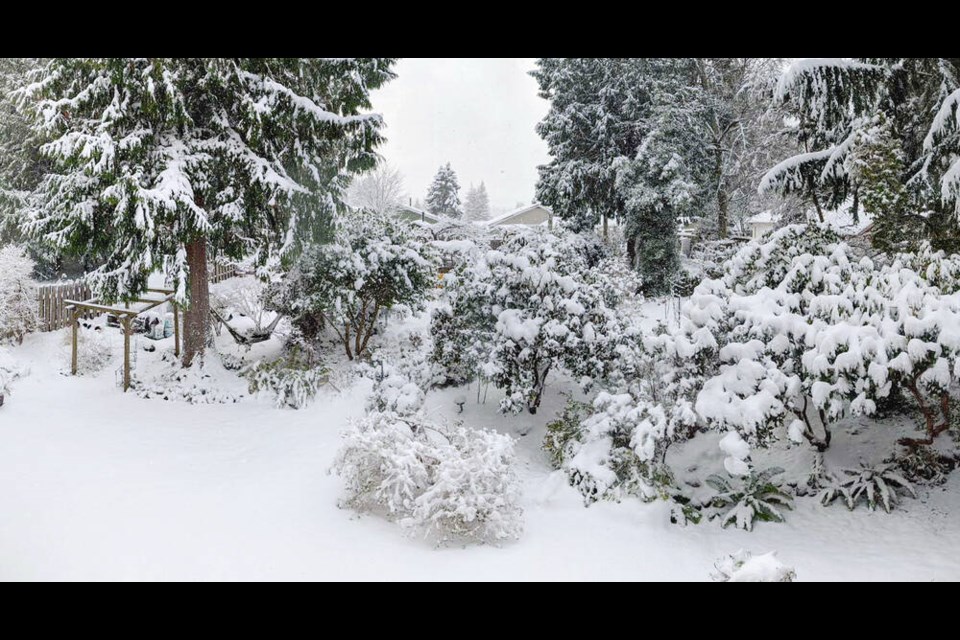Waking on Christmas morning to a world blanketed in white was magical — for those among us well able to deal with inconveniences that can accompany a snowfall. For gardens, it was a blessing. The snow that fell served as an insulating blanket against the plummeting temperatures that followed.
A broken year? The deep freeze that descended on Boxing Day was a final shock in a series of near-epic disasters through most of 2021 — heat dome, drought, wildfires, floods, landslides, and finally an extended period of record-breaking cold, all against the background of a relentless pandemic.
When I look back over the past year, a brief scene from Louise Penny’s latest novel, The Madness of Crowds, comes immediately to mind. It’s the morning of New Year’s Eve in a small Quebec village. An extended family has gathered to usher in the new year together.
The grandmother of the family is taking a walk with a small grandchild, who asks: “Why do we need a new year? Was the old one broken?”
As I read that passage, just weeks ago, I asked myself the same question. Was 2021 a “broken” year?
For many, including those burned or flooded out of their homes, it was a broken year. Heat, drought, and flooding were extremely hard on the agricultural community. Home and community gardens were not immune to the effects of high heat levels and a lack of rain. The fierce “heat dome” in late June and early July descended when many vulnerable edibles were being picked or about to be harvested. Leafy green vegetables fried in the heat, podded peas turned woody, raspberries shrivelled.
And yet, along with the disappointments came reports of bountiful gardens and freezers full of home-grown food. And in the face of an onslaught of bad news, division and rancour, people continued to rejoice in the healing tranquillity of their gardens.
For some, gardening became a kind of glue that bonded people together in mutual support and kindness. One gardener wrote to describe the many gatherings of friends she enjoyed on her patio and back lawn through the spring, summer and early autumn, and the pleasure they took in exchanging gardening information.
Lessons were learned, too. Heat and drought highlighted the benefits of mulching around valued plantings to cool the soil and conserve moisture. Mulching and covering plants before the arrival of freezing temperatures has been effective also in protecting edible and ornamental plants that could otherwise be damaged by severe cold.
Stories celebrating plant discoveries and experiences continued to arrive in my emails throughout the year.
Dual-purpose gift plant
Gail M. wrote to describe her delight in a plant she was given on her birthday late in the year: “I have never been a great fan of poinsettias. On my birthday my daughter-in-law gave me a Gaultheria procumbens. I absolutely fell in love with it. The bright red berries and green leaves were especially cheerful during dark, rainy days. After enjoying the plant indoors, I planted it outside.
“My research indicates the plant is commonly called winterberry or teaberry, and the edible berries taste like mint. I liked the plant so much that I went back to the nursery where it had been purchased, and bought three more to give as gifts. Better than poinsettias, in my opinion.”
Also known as wintergreen, Gaultheria procumbens spreads to form a low-growing ground cover with small, glossy leaves and soft pink flowers in summer followed by scarlet berries in the fall. It is native to eastern North America.
We have our own native west coast species of Gaultheria. The most familiar is Gaultheria shallon, commonly known as salal, it’s a taller, rangier woodland shrub with leathery evergreen leaves, white or pinkish urn-shaped flowers and fleshy, dark purple berries.
Gail’s gift plant was likely a selection of Gaultheria procumbens known as Big Berry, which is often found in garden centres in autumn.
The plant is valued for its year-round interest, both as a ground cover in gardens and as a potted plant. The bright red berries, which remain on the plant through the winter, make it an ideal cold season plant for patios, decks and balconies. This teaberry brightens the winter holidays with its red and green Christmas colours.



